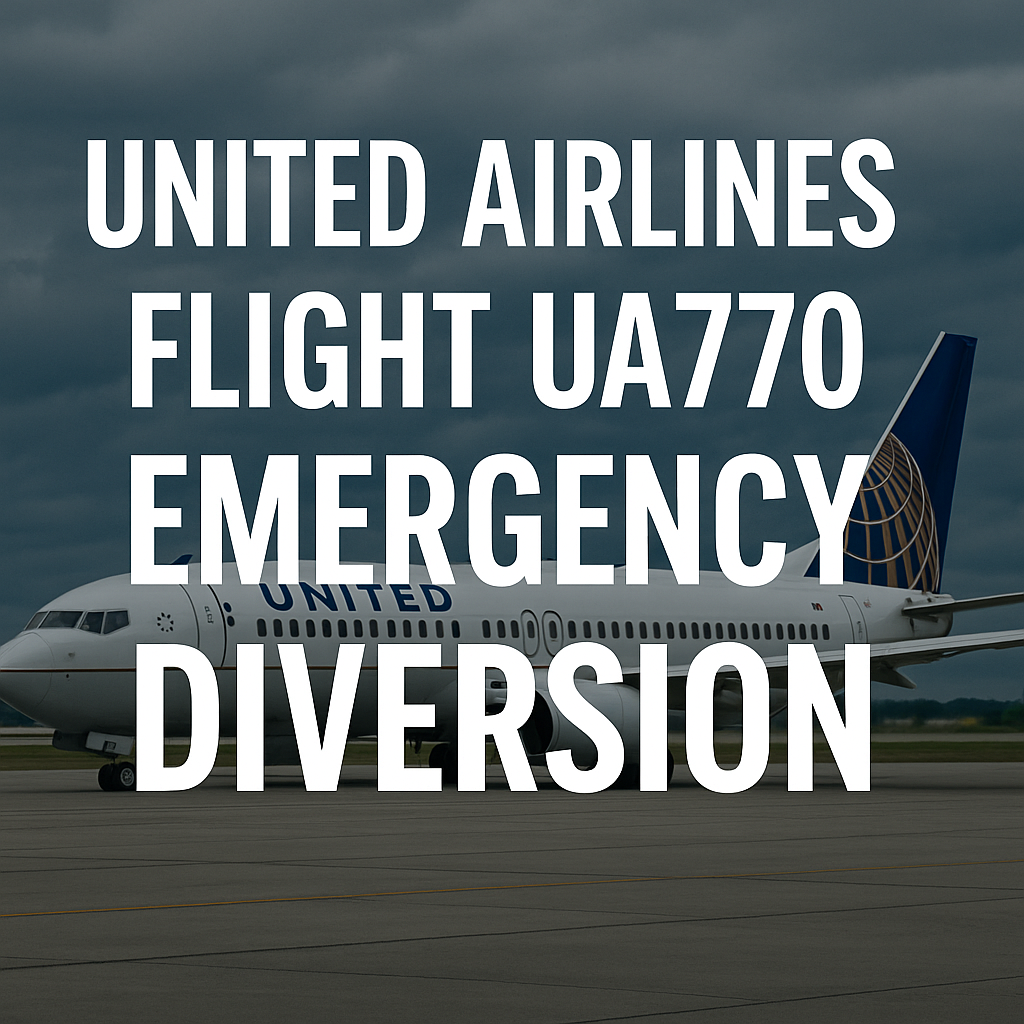United Airlines Flight UA770 Emergency Diversion: What Happened Mid-Air?
On the morning of July 21, 2025, United Airlines Flight UA770 made headlines after an unexpected emergency diversion disrupted its scheduled route. The aircraft, en route from Los Angeles International Airport (LAX) to Chicago O’Hare International Airport (ORD), was forced to land in Denver International Airport (DEN) due to a mid-air emergency that raised immediate safety concerns.
This incident has drawn significant attention, sparking questions around the nature of the emergency, airline safety procedures, and the passenger experience during such diversions. In this article, we explore the details of what transpired on Flight UA770, why emergency diversions happen, and what passengers can expect when such rare but serious situations arise.
A Routine Flight Turns Into an Emergency
United Airlines Flight UA770 took off from Los Angeles at approximately 9:30 AM Pacific Time. The flight, operated by a Boeing 737-900 aircraft, carried 178 passengers and six crew members. The route from LAX to Chicago is one of United’s regular services, typically lasting around four hours and covering a distance of roughly 1,750 miles.
About 90 minutes into the flight, somewhere over the Colorado airspace, the flight crew identified what was initially described as a “mechanical irregularity.” In accordance with United’s strict safety protocols and FAA regulations, the captain declared an emergency and requested a diversion to the nearest suitable airport — Denver International Airport.
Passengers reported a smooth descent with little turbulence and a composed flight crew. The cabin crew informed passengers of the situation without inducing panic, emphasizing that the decision was precautionary and that there was no immediate danger.
Safe Landing in Denver
At approximately 11:15 AM local time, Flight UA770 made a safe landing in Denver. Emergency response teams were on standby at Denver International Airport, a standard procedure in such situations. Thankfully, the aircraft landed without incident, and no injuries were reported among passengers or crew.
After the plane was parked at a remote gate, maintenance crews began inspecting the aircraft to determine the cause of the emergency diversion. Although official confirmation from United Airlines has yet to disclose the specific mechanical issue, early speculation suggested a possible sensor fault or issue related to cabin pressurization.
United Airlines issued a short statement within an hour of the incident:
“United Airlines Flight UA770, operating from Los Angeles to Chicago, diverted to Denver as a precaution due to a potential mechanical issue. The aircraft landed safely, and we are assisting customers with alternate travel arrangements.”
Passenger Reactions and Experience
In the age of social media, incidents like these quickly gain traction. Several passengers shared their experiences on platforms like X (formerly Twitter), Facebook, and TikTok.
One passenger, Sarah Kaplan, wrote:
“We were about halfway to Chicago when the captain came on the intercom and said we’d be landing in Denver instead. Crew was calm and explained everything well. A little scary, but overall we felt safe.”
Another traveler, Michael Torres, praised the professionalism of the crew:
“Kudos to the pilot and flight attendants. No panic, just calm instructions. Landed smoothly and we’re now waiting for updates on our new flights. Could have been worse.”
Passengers were deplaned and taken to the terminal, where United staff helped with rebooking and accommodations. Vouchers for meals and, in some cases, hotel stays were issued to passengers who faced significant delays.
Why Do Emergency Diversions Happen?
Emergency diversions in commercial aviation, while rare, are not unheard of. Airlines and flight crews are trained to respond to a wide range of emergencies — mechanical, medical, or environmental — that could threaten the safety of passengers.
Some of the most common reasons for emergency diversions include:
-
Mechanical Issues: These can range from sensor malfunctions to problems with engines, hydraulic systems, or pressurization.
-
Medical Emergencies: If a passenger or crew member experiences a serious health issue mid-flight, the plane may divert to get medical assistance.
-
Security Concerns: Threats or disturbances onboard can prompt emergency landings.
-
Weather: Sudden storms or turbulence may require a reroute or unscheduled landing.
In this case, although the issue has not been publicly identified, the crew followed standard aviation procedures by opting to land at the nearest major airport with appropriate facilities — Denver International.
What Happens After an Emergency Diversion?
Following an emergency diversion, several processes take place:
-
Inspection of the Aircraft: Airline maintenance crews, along with FAA officials if required, inspect the aircraft to determine the cause of the emergency.
-
Passenger Assistance: The airline coordinates with airport ground staff to rebook passengers on alternative flights or arrange accommodations.
-
Internal Review: The airline’s safety team conducts a review to analyze whether the emergency was handled according to protocol.
-
Regulatory Reporting: The incident is reported to the FAA and possibly to the National Transportation Safety Board (NTSB), depending on the severity.
In most cases, passengers are placed on another flight within a few hours. However, if the diversion happens at a busy airport or late in the day, some travelers may have to wait longer or stay overnight.
The Importance of Crew Training and Passenger Safety
What stood out in the United Airlines Flight UA770 emergency diversion was the level of professionalism shown by the crew. Their calm demeanor, clear communication, and adherence to safety procedures played a significant role in ensuring that passengers remained composed during the ordeal.
Flight attendants undergo extensive training to prepare for emergency situations — from evacuations to in-flight medical incidents and system failures. Similarly, pilots are trained in simulators to respond to dozens of possible mid-air emergencies, allowing them to make split-second decisions under pressure.
This incident reinforces the importance of continuous crew training and the role it plays in maintaining the safety of commercial aviation — which remains one of the safest modes of transportation in the world.
United Airlines: A Focus on Safety
United Airlines has a generally strong safety record, operating thousands of flights daily across the globe. While no airline is immune to occasional incidents, the way these situations are handled is a testament to an airline’s commitment to passenger welfare.
The airline has not faced a major safety crisis in recent years and regularly invests in fleet maintenance, crew training, and safety protocols. The Flight UA770 emergency diversion appears to be another example of safety systems working as intended — detecting a potential problem, rerouting the flight, and landing without injuries or damage.
Read also: LCFGamenews Gaming Updates: Your Ultimate Hub for Gaming News and Insights
Final Thoughts: What We Can Learn from UA770
Though disruptions like the United Airlines Flight UA770 emergency diversion can be unsettling for passengers, they serve as a reminder of how modern aviation is built on layers of precaution and preparedness. From the pilot’s initial decision to divert the flight to the coordination between air traffic control, ground crews, and customer service teams, every link in the safety chain matters.
While the inconvenience of a delayed arrival is frustrating, it is a small price to pay for ensuring passenger safety. Most importantly, all passengers aboard Flight UA770 walked away unharmed — a credit to the well-drilled crew and the systems in place.
As investigations continue and more details emerge, this event will likely become a case study in how emergency diversions should be handled: with calm, clarity, and a commitment to safety above all else.














Post Comment